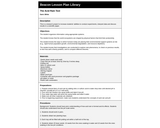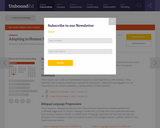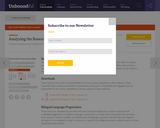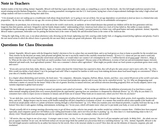
A collection of 101 research writing idea prompts.
- Subject:
- English Language Arts
- Material Type:
- Activity/Lab
- Provider:
- E Reading Worksheets
- Author:
- E Reading Worksheets
- Date Added:
- 02/26/2019

A collection of 101 research writing idea prompts.

Students learn useful, reliable ways to locate materials for personal, academic or professional research projects on NYTimes.com.

In this lesson, students conduct experiments and compile information into a research paper.

Students participate in a fishbowl discussion about various legal situations related to the "age of responsibility" and contribute their ideas and arguments on the matter to a Learning Network Student Opinion blog post. This resource from the New York Times discusses what standard(s) society should use to determine when a youth should be treated as an adult.

This recurring lesson encourages students to comprehend their reading through inquiry and collaboration. They work independently to choose quotations that exemplify the main idea of the text, come to a consensus about those quotations in collaborative groups, then formulate "quiz" questions about their reading that other groups will answer.

In this lesson based on St. Lucy's Home for Girls Raised by Wolves, students will discuss the extent to which the main character of the story has adapted to human society. Students will make a claim and support that claim with textual evidence.

Students will examine changes in African American voting rights throughout North Carolina's history. This lesson begins by reviewing key vocabulary. Students then independently research the history of African American voting rights in North Carolina using a primary source web quest or jigsaw activity.

Students will investigate and discuss problems associated with invasive species. They will then conduct research and prepare a written case study on a specific assigned invasive aquatic species, including information about how it was introduced, impacts associated with its occurrence, and possible control measures.

After taking a virtual tour of the Globe Theater in Elizabethan London, students use graphic organizers to compare attending a performance at the Globe to attending a Broadway play or movie. Then they work collaboratively to create a commercial advertisement geared towards an Elizabethan audience.

This resource includes an extended lesson designed to help students engage with ideals relative to the “American Dream”. The lesson is largely designed to accompany a reading of the novel The Great Gatsby. Students will read articles that discuss the “American Dream” prior to writing their own argumentative essay.

After gaining skill through anazlying a historic and contemporary speech as a class, students will select a famous speech from a list (included) and write an essay that identifies and explains the rhetorical strategies that the author chose while crafting an effective speech. The analysis will consider questions such as: What makes a good argument? How did the author's rhetoric evoke a response from the audience? Why are the words still famous today?

In this lesson, students will complete at least two Forming Evidence-Based Claims Tools for all inquiry paths on their Research Frame.

In this lesson, students will compare/contrast the information in their textbook about Andrew Jackson to political cartoons of the era. Students will identify symbols, allusions and stereotypes used in these cartoons and infer the intended message and tone of the Jackson era cartoons. Students will also identify any biases in the cartoons and check for historical accuracy, and then formulate their own opinion about the Jackson Administration. As a culminating activity, students will write an opinion essay that articulates their personal stance on Andrew Jackson’s character, using proper writing conventions.

This resource is a collection of discussion questions and to supplement Animal, Vegetable, Miracle by Barbara Kingsolver.

In this activity, students will work in collaborative groups to create 9M x 9M models of plant and animal cells. Class population can be split into 2 or 4 groups, with half the students constructing animal cells and the other half constructing plant cells. Students must organize and assign duties, provide materials for this activity, and write a written report. They will also give "Cell Tours" to other students and/or classroom guests.

How are magnetism and electricity related? In this lesson, students will explore the relationship between magnetism and electricity, learn how to construct an electromagnet, and discover everyday uses of electromagnets. Students will create a multimedia presentation in which they will demonstrate their knowledge of electromagnetism.

Students learn about behavioral and biological animal adaptations, watch a video about the Arctic, and research how specific animals have adapted to this harsh environment.

This resource is a collection of discussion questions to supplement The Art of Racing in the Rain by Garth Stein.

Students will consider literary works including Mary Shelly's Frankenstein and research their respective "back stories." They then design posters illustrating their information for display.

A teaching resource for actiities, research assignments, writing prompts and cooperative activities for Ben Franklin including Poor Richard's Almanac.